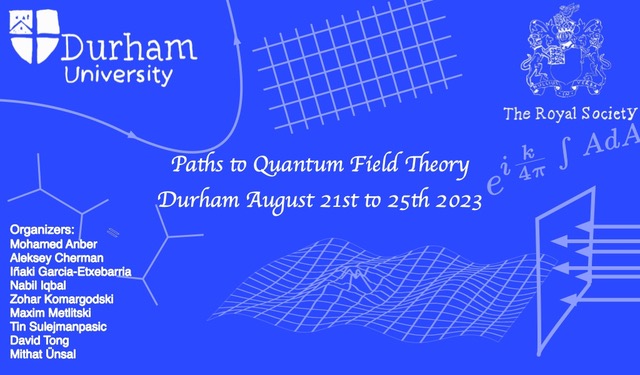- Compact style
- Indico style
- Indico style - inline minutes
- Indico style - numbered
- Indico style - numbered + minutes
- Indico Weeks View
Paths to Quantum Field Theory 2023
→
Europe/London
Mathematical Sciences Building
Mathematical Sciences Building
Description

The registration is now CLOSED!
The workshop will take place in Durham, UK from August 21th to August 25th in 2023. All talks will take place in Scott Logic Lecture Theater in the Mathematical Sciences/Computer Sciences building. The workshop is designed to bring together a small number of expert speakers across the fields related to quantum field theory, including high-energy, nuclear and condensed matter physics, applying a range of techniques from numerical to theoretical and hybrid approaches. The number of formal talks will be quite limited. A typical day will consist of either two talks, with 2 hour slots available to to speakers to use as they wish, or one 2 hour talk and three 30 minute talks. The idea of the longer talks is to enable the speakers to give a thorough introduction to a broad audience and to encourage questions and discussions during the talks. The 30 minute talks allow for several speakers to briefly introduce the participants to exciting recent developments. Curcially between all talks there will be sufficiently long breaks which will allow more in-depth discussions. Finally, we hope that a number of junior researchers will join as participants in discussing and posing insightful questions.
We will fully fund all speakers, and a number of junior participants. If you have questions please contact the organizers using the contact link below.
This is the third workshop in an annual series of "Paths to Quantum Field Theory" workshops. The earlier workshops were held in 2021 and 2022.
Link to the YouTube channel: https://m.youtube.com/@DUMathSc?cbrd=1&pli=1
Link to previous workshops
2022: https://indico.cern.ch/event/1162387/
2021: https://indico.cern.ch/event/1038599/
Confirmed speakers:
Luca Delacretaz
Anton Kapustin
Ho Tat Lam
Michael Levin
Anders Sandvik
Nathan Seiberg (cancelled)
Ruben Verresen
Carolyn Zhang
Organizers
Mohamed Anber
Aleksey Cherman
Iñaki Garcia-Etxebarria
Nabil Iqbal
Zohar Komargodski
Maxim Metlitski
Tin Sulejmanpasic
David Tong
Mithat Ünsal
Travel to Durham:
Travel by air:
The closest airports to Durham are Newcastle International Airport and Teesside International Airport. Durham is 30 minutes drive from Newcastle International Airport and about 40 minutes from Teesside International Airport. Both have regular domestic and international flights. You can take a taxi or Uber from either airport to your accommodation in Durham.
You may also travel to Heathrow airport in London and take the train from London to Durham. Notice, however, that you will first need to take the metro from Heathrow airport to King’s Cross Railway station (one-hour ride) and then the train from King’s Cross Railway station to Durham (3 hours).
You should check the national railway https://www.nationalrail.co.uk/ before planning your trip for possible strikes.
Travel by Rail (inside the UK):
InterCity trains from the most main centers in the country call at Durham daily along the main East Coast Main Line, including the London North Eastern Railway. Transpennine Express offers frequent links to Manchester, Sheffield, and Leeds, while Cross Country links Durham directly with Scotland, the Midlands, and the South West, and Northern Railways also use this line.
Durham is just 3 hours from London, a bit over 3 hours from Birmingham, 2½ hours from Manchester, 1½ hours from Edinburgh, 45 minutes from York, and 14 minutes from Newcastle Upon Tyne.
Tourism in Durham:
Durham offers terrific historical and natural attractions. Consult the webpage https://www.thisisdurham.com for further information.
Registration
Participants
Participants
Abigail Timmel
Adi Armoni
Aleksey Cherman
Ali Fatemiabhari
Alistair Chopping
Ana Retore
Anatoly Konechny
Anders Sandvik
Anton Kapustin
Arkya Chatterjee
Arpit Das
Arvind Shekar
Ben Hoare
Cameron Scott
Carlos Nunez
Carolyn Zhang
Christof Gattringer
Davi Bastos Costa
David Tong
Deepali Singh
Erich Poppitz
Felix Christensen
Gabriel Arenas-Henriquez
Guilherme Delfino
Ho Tat Lam
Iñaki García Etxebarria
Jamie Pearson
Liujun Zou
Luca Delacretaz
Lucca Fazza
Madalena Lemos
Maria Neuzil
MAX METLITSKI
Mendel Nguyen
Michael Levin
Mohamed Anber
Mohammad Akhond
Murtaza Jafry
Nabil Iqbal
Nakarin Lohitsiri
Napat Poovuttikul
Pratyusha Chowdhury
Rashad Hamidi
Ricardo Stuardo
Rishi Mouland
Robert Jones
Ruben Verresen
Ruchira Mishra
Rudolfs Treilis
Ryan Lanzetta
Salvatore Pace
Samson Chan
Siddharth Vadnerkar
Simon Ross
Stefano Cremonesi
Thomas Dumitrescu
Tin Sulejmanpasic
Tyler Helmuth
Visagan Ravindran
Zechuan Zheng
Zohar Komargodski
Surveys
Paths to QFT Workshop Dinner



